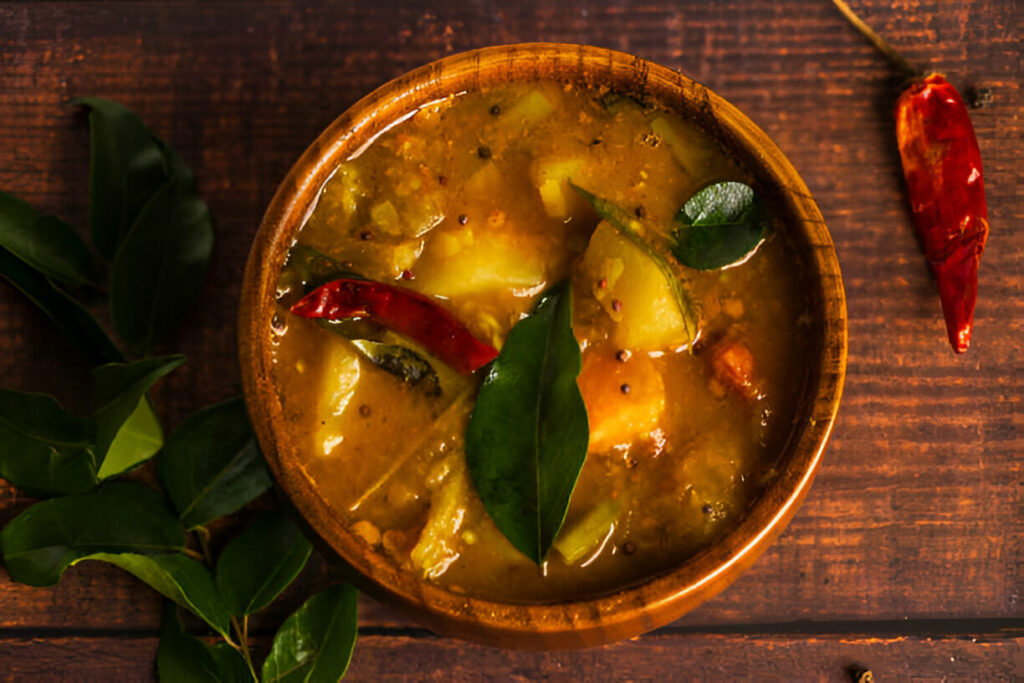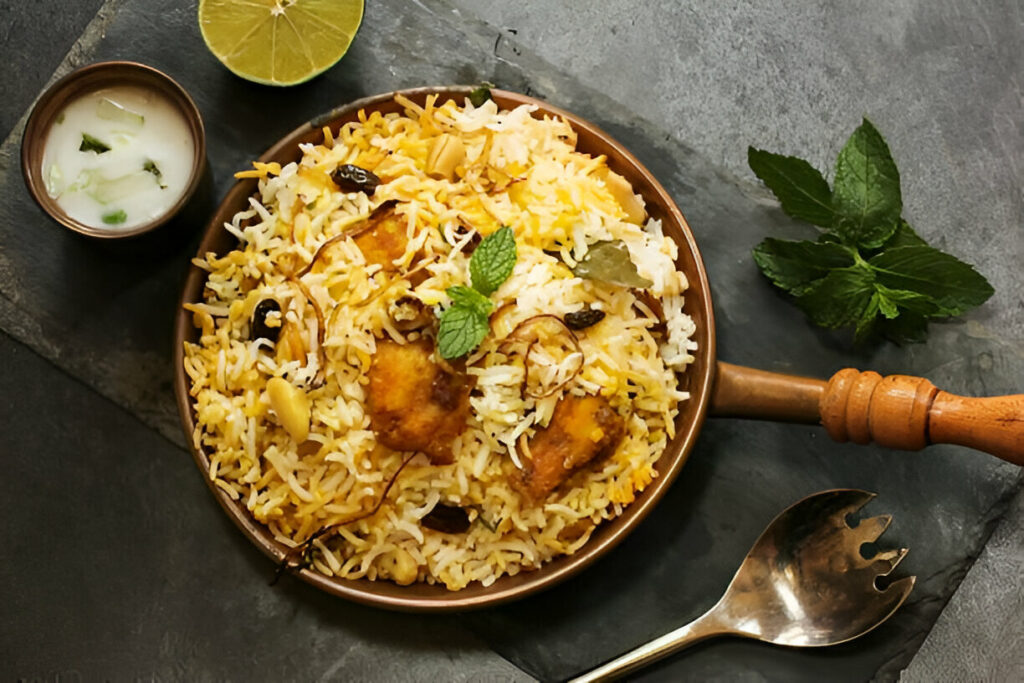South Indian
Indian Cuisines
Sambar
Sambar is a South Indian lentil-based stew made with vegetables, tamarind, and spices like turmeric, cumin, and coriander.
Vegetable Pulao
Vegetable pulao is a popular and versatile dish. It is known for its aromatic flavors, thanks to a blend of fragrant basmati rice, assorted vegetables, and a medley of spices.
Dosa
Dosa is a popular South Indian dish that has gained widespread popularity across India and beyond.
Hyderabadi Biriyani
Avial
Avial is a traditional South Indian dish made with assorted vegetables cooked in a coconut-yogurt gravy, seasoned with curry leaves and coconut oil.

Sambar
Sambar is a tangy and flavorful South Indian dish, a lentil-based vegetable stew. It’s made by cooking pigeon peas (toor dal) with a variety of vegetables like drumsticks, carrots, eggplant, and tomatoes. The dish is seasoned with a blend of spices including coriander, cumin, fenugreek, and asafoetida, imparting its distinctive taste. Tamarind pulp or tomatoes provide the characteristic tanginess, while curry leaves and mustard seeds add aroma and depth. Sambar is often served with steamed rice or as an accompaniment to dosa and idli, making it a staple in South Indian cuisine for its comforting and nutritious qualities.
- Ingredients
- Method
For cooking dal:
- 1/2 cup toor dal (split pigeon peas)
- 2 cups water
- 1/4 teaspoon turmeric powder
For sambar:
- 1 small onion, chopped
- 1 medium tomato, chopped
- 1 small carrot, diced
- 1 small potato, diced
- 5-6 okra (ladyfinger), cut into pieces
- 1/2 cup tamarind extract (made by soaking a small lemon-sized ball of tamarind in water)
- 2 tablespoons sambar powder (store-bought or homemade)
- Salt to taste
For tempering (tadka):
- 2 tablespoons oil (preferably coconut oil)
- 1 teaspoon mustard seeds
- 1 teaspoon cumin seeds
- 2-3 dry red chilies
- A pinch of asafoetida (hing)
- Few curry leaves
Cooking dal:
- Rinse the toor dal under running water until the water runs clear.
- In a pressure cooker or a pot, add the rinsed toor dal along with 2 cups of water and turmeric powder.
- Pressure cook for about 3-4 whistles (or simmer in a pot until the dal is soft and cooked through). Once done, mash the dal well using a spoon or a dal masher. Set aside.
Preparing vegetables:
- While the dal is cooking, prepare the vegetables. Chop the onions, tomatoes, carrots, potatoes, and okra as mentioned.
Making sambar:
- In a large pot, combine the cooked dal and add all the chopped vegetables (onions, tomatoes, carrots, potatoes, and okra).
- Add salt to taste and cook the vegetables until they are tender, stirring occasionally.
Adding tamarind extract:
- Once the vegetables are cooked, add the tamarind extract to the pot. Adjust the quantity based on your preference for tanginess.
Adding sambar powder:
- Add the sambar powder to the pot. Sambar powder is a mix of various spices like coriander, cumin, fenugreek, red chilies, etc., which gives sambar its distinct flavor. Adjust the quantity based on your spice preference.
Simmering:
- Mix everything well and let the sambar simmer for 10-15 minutes on low heat. This helps all the flavors to blend together.
Preparing tempering (tadka):
- In a small pan, heat oil over medium heat.
- Add mustard seeds and let them crackle.
- Add cumin seeds, dry red chilies, asafoetida, and curry leaves. Fry until the red chilies turn darker and curry leaves become crisp.
Adding tadka to sambar:
- Pour the tempering (tadka) over the sambar and immediately cover the pot to trap the aroma.
Final touches:
- Stir the sambar gently to mix in the tempering.
- Taste and adjust salt or tamarind if needed.
Serving:
- Serve hot sambar with steamed rice, idli, dosa, vada, or any South Indian breakfast or main dish.

Vegetable Pulao
Vegetable Pulao is a fragrant and flavorful rice dish popular in Indian cuisine. It’s made by cooking basmati rice with assorted vegetables like carrots, peas, beans, and potatoes. The dish is seasoned with a blend of spices such as cumin, cloves, cinnamon, and bay leaves, often infused with ginger and garlic for added aroma. Vegetable Pulao is typically cooked in ghee or oil, which enhances its richness, and sometimes garnished with fried onions and cashews for texture and crunch. It’s a versatile dish enjoyed as a main course or as a side dish with yogurt or raita.
- Ingredients
- Method
- 1 cup basmati rice (or any long-grain rice)
- 2 cups water
- 1 tablespoon ghee or oil
- 1 small onion, thinly sliced
- 1 small carrot, diced
- 1 small potato, diced
- 1/2 cup green peas (fresh or frozen)
- 1/2 cup cauliflower florets
- 1/2 cup green beans, chopped
- 1-2 green chilies, slit (optional, adjust to taste)
- 1-inch piece of ginger, finely chopped or grated
- 2-3 cloves garlic, minced
- 1 teaspoon cumin seeds
- 1 bay leaf
- 2-3 cloves
- 2-3 green cardamom pods
- 1-inch cinnamon stick
- Salt to taste
- Fresh cilantro (coriander) leaves for garnish (optional)
Preparation:
- Rinse the basmati rice under cold water until the water runs clear. Soak the rice in water for 20-30 minutes. Drain before using.
- Prepare the vegetables: chop the onion, carrot, potato, cauliflower, and green beans. Keep aside.
Sautéing the spices:
- Heat ghee or oil in a large pan or pot over medium heat.
- Add cumin seeds, bay leaf, cloves, green cardamom pods, and cinnamon stick. Sauté for about 30 seconds until fragrant.
Adding aromatics:
- Add sliced onions and green chilies (if using). Sauté until the onions turn translucent.
Adding vegetables:
- Add chopped ginger and minced garlic. Sauté for another minute until the raw smell disappears.
- Add all the chopped vegetables (carrot, potato, cauliflower, green beans) and green peas. Stir fry for 3-4 minutes until the vegetables are slightly tender.
Cooking rice:
- Drain the soaked rice and add it to the pan. Stir gently to combine with the vegetables and spices.
- Pour 2 cups of water into the pan. Season with salt according to your taste.
Simmering:
- Bring the mixture to a boil over high heat. Once boiling, reduce the heat to low, cover the pan with a tight-fitting lid, and let it simmer for 15-20 minutes, or until the rice is cooked and all the water is absorbed. Do not stir the rice while it’s cooking to avoid breaking the grains.
Fluffing and serving:
- Once the rice is cooked, remove the pan from heat and let it sit covered for another 5 minutes. This helps the rice grains to firm up.
- Remove the lid, gently fluff the pulao with a fork to separate the grains.
- Garnish with fresh cilantro leaves if desired.
Serve hot:
- Vegetable pulao is ready to be served as a main dish or as a side dish with yogurt, raita, or any curry of your choice.

Dosa
- Ingredients
- Method
For Dosa Batter:
- 1 cup regular rice (preferably idli rice)
- 1/2 cup urad dal (split black gram)
- 1/4 teaspoon fenugreek seeds (methi seeds)
- Water for soaking and grinding
- Salt to taste
For Making Dosa:
- Dosa batter (prepared as per instructions below)
- Oil or ghee for cooking dosa
Preparing Dosa Batter:
Soaking:
- Rinse the rice and urad dal separately under running water until the water runs clear.
- In a large bowl, combine the rice, urad dal, and fenugreek seeds. Add enough water to cover the mixture by a few inches. Let it soak for at least 4-6 hours, preferably overnight.
Grinding:
- Drain the soaked rice, urad dal, and fenugreek seeds. Reserve the soaking water.
- In a blender or wet grinder, grind the urad dal first until it becomes smooth and fluffy, adding a little water as needed. The consistency should be similar to whipped cream.
- Transfer the ground urad dal to a large bowl.
- Next, grind the soaked rice in batches until you get a smooth batter. Add water gradually as needed to facilitate grinding. The consistency of the rice batter should be slightly coarse, similar to fine semolina (sooji).
- Combine the ground rice batter with the urad dal batter in the bowl.
- Add salt to taste and mix the batter well using your hands. The batter should be slightly thick yet pourable. Add reserved soaking water if needed to adjust the consistency.
Fermentation:
- Cover the bowl with a clean kitchen towel or lid and let the batter ferment in a warm place for 8-12 hours or overnight. During fermentation, the batter will rise and become slightly bubbly.
Making Dosa:
Preparing the Griddle (Tava):
- Heat a non-stick dosa tava (griddle) or a large flat skillet over medium-high heat.
- Once hot, sprinkle a few drops of water on the tava. If the water sizzles and evaporates immediately, the tava is ready.
Cooking Dosa:
- Stir the dosa batter gently. If the batter is too thick after fermentation, you can add a little water to adjust the consistency.
- Pour a ladleful of batter onto the center of the hot tava. Using the back of the ladle, spread the batter in a circular motion to form a thin, even layer. Start from the center and work your way outwards.
- Drizzle a little oil or ghee over the dosa and around its edges.
- Cook the dosa on medium-high heat until the edges start to turn golden brown and crispy, and the surface of the dosa appears cooked.
Folding and Serving:
- Using a flat spatula, loosen the edges of the dosa from the tava.
- Gently fold the dosa in half or roll it into a cylinder. Remove from the tava and serve hot immediately.
- Repeat the process with the remaining batter, adjusting the heat and spreading the batter as needed.
Serving Suggestions:
- Serve dosa hot with coconut chutney, sambar, or any spicy curry of your choice.

Hyderabadi Biriyani
Hyderabadi Biryani is a cherished dish from Hyderabad, India, renowned for its aromatic spices and rich flavors. It combines layers of fragrant basmati rice with marinated meat (often chicken or mutton), cooked in yogurt and a medley of spices. The dish is cooked in the traditional “Dum” style, slow-cooked in a sealed pot to blend the flavors perfectly. Garnished with fried onions, mint leaves, and served with raita, Hyderabadi Biryani exemplifies the culinary finesse and royal heritage of Hyderabad’s Nizams.
- Ingredients
- Method
For Marinating Chicken:
- 500 grams chicken, cut into pieces (preferably with bones, for more flavor)
- 1 cup yogurt (curd), whisked
- 1 tablespoon ginger-garlic paste
- 1 teaspoon red chili powder
- 1/2 teaspoon turmeric powder
- 1 teaspoon garam masala powder
- 1 teaspoon ground coriander
- 1 teaspoon ground cumin
- Salt to taste
- Freshly squeezed juice from 1 lemon
For Rice:
- 2 cups basmati rice, soaked in water for 30 minutes and drained
- 4-5 cups water
- 1 bay leaf
- 2-3 green cardamom pods
- 1-inch cinnamon stick
- 4-5 cloves
- Salt to taste
For Layering:
- 2 large onions, thinly sliced and fried until golden brown (birista)
- 1/4 cup chopped fresh mint leaves
- 1/4 cup chopped fresh cilantro (coriander) leaves
- Saffron strands soaked in 2 tablespoons warm milk
- 2 tablespoons ghee (clarified butter)
- 2 tablespoons oil
Whole Spices for Biryani Masala:
- 1 bay leaf
- 4-5 green cardamom pods
- 4-5 cloves
- 1-inch cinnamon stick
- 1 star anise
- 1 teaspoon shahi jeera (black cumin seeds)
- 1 strand of mace (optional)
Marinating Chicken:
- In a large bowl, combine the chicken pieces with yogurt, ginger-garlic paste, red chili powder, turmeric powder, garam masala powder, ground coriander, ground cumin, salt, and lemon juice. Mix well to coat the chicken pieces evenly with the marinade. Cover and refrigerate for at least 1 hour, preferably longer (4-6 hours or overnight) for the flavors to meld.
Cooking Rice:
- In a large pot, bring 4-5 cups of water to a boil.
- Add the soaked and drained basmati rice along with bay leaf, green cardamom pods, cinnamon stick, cloves, and salt to taste.
- Cook the rice until it is 70-80% cooked (al dente). Drain the rice and set aside.
Assembling and Layering Biryani:
- Heat 2 tablespoons of ghee and 2 tablespoons of oil in a heavy-bottomed pot or deep pan.
- Add the whole spices for biryani masala (bay leaf, green cardamom, cloves, cinnamon stick, star anise, shahi jeera, and mace) and sauté for a minute until fragrant.
- Add half of the marinated chicken pieces along with some marinade. Cook on medium-high heat for about 5-7 minutes, stirring occasionally, until the chicken is partially cooked and the marinade reduces slightly.
- Remove half of the partially cooked chicken pieces and spread them evenly in the pot.
- Layer half of the partially cooked rice over the chicken layer.
- Sprinkle half of the fried onions (birista), chopped mint leaves, and chopped cilantro leaves over the rice.
- Repeat the layers with the remaining chicken, rice, fried onions, mint leaves, and cilantro leaves.
- Drizzle the saffron milk evenly over the top layer.
- Cover the pot with a tight-fitting lid. You can also seal the lid with a layer of dough (atta) to trap the steam inside.
- Reduce the heat to low and cook the biryani for 20-25 minutes, allowing the flavors to meld together and the chicken to cook through completely.
- Once done, turn off the heat and let the biryani rest for 10-15 minutes before opening the lid.
- Gently fluff the biryani with a fork to mix the layers while being careful not to break the rice grains.
Serving:
- Serve Hyderabadi Chicken Biryani hot with raita (yogurt dip), salad, or any side dish of your choice.

Avial
Avial is a traditional South Indian dish originating from Kerala, renowned for its creamy texture and aromatic flavors. It consists of assorted vegetables such as drumsticks, carrots, and pumpkin, cooked in a coconut-yogurt gravy seasoned with curry leaves and coconut oil. The dish is flavored with a paste of fresh coconut, green chilies, and cumin seeds, giving it a rich and distinctive taste. Avial is often served as a side dish with steamed rice, complementing its mild yet satisfying blend of vegetables and coconut essence, making it a favorite in South Indian cuisine.
- Ingredients
- Method
- Assorted Vegetables: Commonly used vegetables include drumsticks, carrots, beans, raw banana (plantain), ash gourd (winter melon), pumpkin, yam, and potatoes. You can use a combination of these or any other vegetables of your choice.
- Coconut: Fresh grated coconut or coconut pieces.
- Yogurt: Plain, thick yogurt (curd).
- Green Chilies: For spice, adjust to taste.
- Cumin Seeds: For grinding into a paste.
- Curry Leaves: Fresh curry leaves for seasoning.
- Coconut Oil: Traditionally used for its flavor.
- Turmeric Powder: For color and flavor.
- Salt: To taste.
Prepare the Vegetables:
- Peel and chop the vegetables into medium-sized pieces. If using drumsticks, cut them into 2-3 inch lengths.
- Boil or steam the vegetables until they are just tender. Be careful not to overcook them, as they should retain some firmness.
Make the Coconut Paste:
- Grind together grated coconut, green chilies, and cumin seeds into a smooth paste using a little water as needed. The paste should be thick and creamy.
Cooking Avial:
- In a wide pan or kadai, heat coconut oil over medium heat.
- Add the boiled vegetables and stir gently to mix.
- Sprinkle turmeric powder and salt over the vegetables.
Adding Coconut Paste:
- Add the ground coconut paste to the vegetables and mix well to coat them evenly.
- Reduce the heat to low and cook for a couple of minutes, stirring gently, to allow the flavors to blend.
Adding Yogurt:
- Remove the pan from heat. Gradually add thick yogurt to the vegetables and coconut mixture, stirring gently to combine. Ensure the yogurt is well incorporated without curdling.
Seasoning:
- In a small pan, heat a little more coconut oil.
- Add mustard seeds and let them splutter.
- Add curry leaves and sauté for a few seconds until they are fragrant.
- Pour this tempered oil over the avial and mix gently.
Serve:
- Transfer the avial to a serving dish.
- Serve hot with steamed rice or as a side dish with any South Indian meal.
